TPG Week 5: Punctuation. ‘Nuff Said.
The Gloriously Lonesome Rebirths of Aaron Funk
Page 1 (6 panels)
Panel 1
A dark swamp. It is night time, but it is so overgrown that it is probably still dark during the day. There is a large moon lighting the scene. In the background we can see the silhouette of what will turn out to be Aaron. He is a large muscular Caucasian man with a huge mane of light brow hair, standing up strait, dressed in only a loin cloth, with his hands held up towards the sky. (Whoa. Okay. I’m not getting much of a sense of place here. I can’t see where the camera should be. First, you’re saying the swamp is dark, and would probably be so in daylight. Then, yo usaw that the moon is lighting the scene. Which is it? Then you say there’s a guy in a loincloth in the background. If the sawmp is dark, how are we supposed to see him, even in silhouette? This makes no sense. Throw your artist a bone.)
Cap(narrator): Shall I tell you all of Aaron Funk?
Panel 2
The same scene, but we are now closer to Aaron, just close enough to make him out as a human man. He has not moved. (A human man? As opposed to what? There are times when you want to be clear, and there are times when you don’t want to clutter the panel description with useless words. That turn of phrase is useless.)
Cap(narrator): Of his life (Mini-rant time. Everyone: when you’re writing a script, keep two things in mind: your creative team, and your audience. When writing full script, the panel descriptions and such are roadmaps for the creative team to do their jobs. That’s fine. No one is going to read that, and you can make any mistakes that you want. No one is going to care. However, your dialogue IS going to be read, and that means you have to know your punctuation. There are WAY too many people calling themselves writers who don’t know much about writing. They didn’t pay attention in English class, but they want to tell a story. You want to get a job writing comics? You want readers to keep coming back? FIX YOUR STUFF. Punctuation is your friend. End of rant. Now, put an ellipsis at the end of this line.)
Panel 3
Closer still on Aaron. He has not moved since the last panel, but now huge arcs of lighting stretch from his hands to the clouds. It is unclear if the lightning is coming from the clouds to his hands, or vice-versa. His face, now well light by the lightning is wildly contorted by either agony or ecstasy. (If you had made your first panel clearer, this would be clearer, too. Well light by the lightning? I take it you meant well lit. And I also take it you meant to put a comma there, too. Now, as for that lightning, it’s going to be REALLY difficult to show indecision of it. Normally, I’d leave it as a decision for the artist, but I’m calling it out because you need to know what can and cannot be drawn. )
Cap(narrator): Of his victories (There are some things that I really dislike. Over-writing is one of them. The sad part? We’re only three panels in on the first page. And you see that missing punctuation? That could either be a period or an ellipsis. I can’t correct it because it could be read differently, depending on the punctuation you put down. This is where we’d have a conversation about how you would want the piece to read. This is what I’m talking about in my rant.)
Aaron: AAAAARGH!!
Panel 4
New scene. Night time in a dark bedroom. We see the silhouette of Aaron in the middle of an intimate moment with a buxom young woman. (If it’s dark, how can we see silhouettes? If it’s dark, WHY would we see silhouettes? How are we supposed to know this is a bedroom? Where is it? A suburb will look different from a high rise, which looks different from a condo, which looks different from a mansion. Throw the artist a bone.)
Cap(narrator): his conquests (Punctuation, and possibly capitalization.)
Panel 5
New scene. High shot looking down at Aaron in the middle of a desert next to the body of a dead camel, which is bleeding from multiple wounds. Aaron or looking up at the sky in anguish, with the camel’s blood all over his hands. As before, he is dressed in only a loin cloth. (I have no idea what that second sentence is supposed to mean. The panel description is supposed to be clear. The artist shouldn’t have any questions regarding what you’re saying. Simple questions like, what time of day is it? Does the camel have a have a harness, halter, and bit? Are there any supplies around? Does Aaron have a weapon? Should it be intimated that he killed the camel? This is what happens when you are unclear.)
Cap(narrator): and failures (You have me shaking my head here. Like I said before, punctuation is your friend.)
page 1 (continued)
panel 6
New scene. Mid afternoon. Winter time in rural Japan. Aaron, in his loin cloth, is fighting what appears to be an entire army of ninjas with only his bare hands, one of whom has just chopped his head off. His head is facing us, and looks rater surprised. (Rater. One that rates. It’s a real word, and because of that, your spell-check didn’t catch it. It is a tool, but it is not a crutch. If I were getting this as a cold submission working for a company, this would be round-filed, and you wouldn’t be hearing from me. I wouldn’t have gotten off the first page. Punctuation, clarity, and spelling.)
Cap(narrator): at least one of which proved fatal (And even more punctuation. At the very least, there should be a period, because we’re at the end of the page.)
Page 2 (7 panels)
Panel 1
Planet earth. A large arrow points to the middle of Canada.
Cap(narrator): How he was born here (It’s P2, and I’m already tired of the writing. The narration is uninteresting. Downright boring, really. Your readers aren’t going to want to stand for it. It’s the beginning and P2, and you haven’t said anything worth reading since the first panel.)
Panel 2
Map of India and the surrounding area.
Cap(narrator): or maybe, specifically, here (Canada is okay, but only barely. Being from the northern hemisphere in general and North American in particular, Canada is easy to spot. Not so for India. Not for North Americans. Not when you haven’t called for any labels on the maps. But if he was born in Canada, how can he be born in India? I don’t care about the fact he died. I’m wondering how a person can be born twice.)
Panel 3
Day time. A wide low shot of an English hospital. A sign in the foreground tells us that it is Stokemanderville, England Maternity Unit . (Is it big? Is it small? Is it the present? Is it the past? Is it bustling? Are there any people seen at all? Clarity.)
Cap(narrator): or here. No one really knows. (Capitalization. At least there’s punctuation.)
Cap(narrator): Its beside the point. (I hate this line. This line right here. Why? Besides the misuse of the apostrophe, you’ve changed the voice of the narrator. This is a cardinal sin. Here’s a visual: your narrator, before this, was wearing a suit and tie. This line has him wearing jeans, sneakers, and a baseball cap that’s backwards. All because of a contraction. Consistency. Make sure your characters stay in their same voice.)
Panel 4
New scene. Night time. A spooky looking graveyard. Its raining. A tall, beautiful woman is looking down at a shabby grave stone, which has no flowers or wreaths on it at all. (You’re bouncing all over the place. Because of that, you’re putting a wall up between the story and your audience. They’re not settled. They don’t have anything to anchor them. That’s first. Second, what is the woman wearing? Is it formal, or is it casual? What’s the timeframe? I’m getting a sense of parts of this taking place in the past, and the artist is going to need to know how to dress the cast. Next, where is the camera? It could be a few different places, but it needs to be placed for maximum effect.)
Cap(narrator): How he died (Punctuation.)
Panel 5.
Close up of an open hard back book lying on a messy writing desk. Blotting paper, ink wells and dip pend are strewn around the place. The previous panel is revealed to be an illustration in the open book. (I don’t know where to begin. Pend? Okay. That’s where I started. Now, if the previous panel is supposed to be a drawing in that book…why not let the artist know beforehand? This way, the artist knows to draw things in a different style. It’s perfectly okay to talk to your artist in the script. Okay, Graeme, the first couple of pages are going to be in a different syle, because they’re actually pages from a book. This way, your artist, Graeme McFreelancer, isn’t banging his head against the desk because he didn’t draw it to best effect, because you didn’t tell him. Clarity.)
narrator(o.p.): And… (And here is where you fail, and fail hard. If the Narrator has been speaking this entire time, then all of his captions need quotation marks because he’s doing a voice-over, NOT doing either an internal monologue or being the omniscient narrator that I thought he was. Why is this such a big failure? Because this could have gone two ways: word balloons to the off-panel Narrator, like this one, or quotations around the captions. But here’s the thing: because you weren’t clear to Graeme, he’s not going to know right off the bat that the first couple of pages need to be in a different style. If these were word balloons, that would be a big tip-off that we were looking at a book or something. It’s not something adequately relayed in captions. And the voice-over, while okay, needs to have the quotations because the narrator is actually talking. You’re going to have to wait in order to get to the biggest failure of this piece.)
page 2 (continued)
Panel 6
The narrator addressing the camera. He is a middle-aged man in a bad, but probably expensive, suit. He is sitting in a cozy looking wood paneled office, with a wall sized bookcase filled with leather-bound books behind him. In the foreground we see the desk from the previous panel. His expression is prim and business like. It is important not to show what is on this side of the desk until the reveal in a few pages time. (Is he actually addressing a camera, or is he addressing someone on the other side of the camera? Important question.)
narrator: how he was… (Capitalization.)
Panel 7
Same angle. The narrator is now clutching his throat with both hands. He now looks very worried. (This should have happened in two panels. One where he begins feeling ill, and the second where he looks very worried. Probably with his throat bulging.)
narrator: …gluck…
Page 3 (1 panel)
Splash!
Aaron’s head and torso have burst out of the narrator’s mouth, which has stretched to a grotesque size in order to accommodate his considerable girth. Aaron is covered in bile and spit, and in one hand holds a large pair of shears, the type used for cutting hedges. The narrator has stood up in a hurry, an in doing so knocked over both his chair, and his desk which is falling towards us. (Impossible, but let’s not go into that for now. From a purely Xtro-like perspective, I like it. And if you haven’t seen Xtro, DO SO! Now, let’s get back to the impossible part, with a great/bad 80s movie comparison. In order for Aaron to come out of someone’s mouth, he’s going to need to be pretty damned narrow. If he’s not narrow, he’s going to kill the person he came out of. That’s first. Second, where do the shears come from? Third, what is he wearing? Fourth, where did he come from? Fifth, are we going to get to a point soon? After the over-writing and fast read of the first two pages, if readers get this far, they’re going to want to have something of substance. This isn’t it. Sixth, this isn’t the best place for a splash page. Not if you’re going to print it. Because here’s what happens: this is an odd-numbered page. Odd pages, when printed, are on the right. Even pages are on the left. You don’t need to turn the page for odd-numbered pages. You just slide your eyes over. This is why splash pages make more impact when they’re on even-numbered pages. You have to turn the page to get there. There’s no page turn here. Just an eye-slide. The only good thing I can really see here, though, is that this is a striking image. I understand that this is comics, but I still don’t like the impossibility of it.)
SFX: SPURRRRNNNNGGGGGRRRRRRRRRCHHHHHHHHHHH!!!!!!!
TITLE: The Gloriously Lonesome Rebirths Of Aaron Funk
Page 4 (4 panels)
Panel 1
Aaron is sill half in and half out the narrator’s mouth. He is now holding the shears in both hands and has them positioned round the back of the narrator’s head with the blades round his neck, as if about to cut off said narrator’s head. Aaron looks determined, and a bit miffed. (Is he coming out of his head, or out of his throat? See the reason for the question? Because if he cuts the head off, won’t he cut himself in half, or something like that? I’m not getting the logic behind this. If he has enough magic to come out basically unharmed, why is the narrator still virtually unscathed? He should be dead right now. And by virtually unscathed, I mean he still has his head, which is still connected to his body.)
SFX: SSHLUUCK
Panel 2
Aaron, still half out of the narrator’s mouth, has closed the shears, cutting the head off the narrator. The narrator’s head, and Aaron in it, are currently in free-fall. In the background we can see the narrator’s body flailing about with a huge fountain of blood spurting from his severed neck. (Moving panel. Closing the shears and falling cannot be done in one panel. Pick one action or the other, but not both. And to be honest, I don’t know why he hasn’t cut himself in half, either.)
SFX: SKOOOSH!
Panel 3
The narrator’s head has fallen to the floor. Aaron has forced one of his legs through one of the narrator’s eye sockets, popping the eye out in the process. Said eye is flying though the air. (If I had trouble with the logic of a man being born from someone’s mouth, imagine my trouble with forcing an entire leg through an eye socket. Besides that, I’m having trouble seeing the storytelling point of this.)
SFX: PLUKCHE!
Panel 4
Aaron is trying to stand up with his one free leg, using one of his hands for support. His other leg had just popped through the other eye socket. (As a page, this is a VERY fast read. No one says anything at all. As a comic, it will take about five seconds to go through the entire thing, because there isn’t anything there to keep a reader. He comes out of the narrator’s skull. Ho-hum. Besides being impossible, how is this page pushing the story forward? It isn’t. It’s stalled, right here. And the stalling, coupled with the over-writing, has made your prospective audience put this back on the shelf, if they picked it up in the first place. This entire page? Padding.)
SFX: PLUKCHE!
Page 5 (6 panels)
Panel 1
Aaron is now standing up, looking down at himself, and, in particular, the head of the narrator, which he is wearing as a sort of underwear. (Pacing. In the last panel, I’m struggling to see him in a good position, because you don’t adequately describe it. In this panel, it seems like he’s finally settled into the guy’s skull and ready to go walkabout. If he was mostly on the ground in the previous panel, why is he standing and ready for action in this one? Pacing.)
Aaron: I’m terribly sorry to say this Sir… (Remember my rant about punctuation? Same thing, here. You forgot the comma. At least the ellipse is correct. And is he going to sound proper and British when he just birthed himself out of someone’s head?)
Panel 2
Aaron has turned and is now addressing the headless body of the narrator. (Why? Why is he addressing the body of the narrator? He’s wearing the head. Why not continue to address it? Or at least, go about his business with whatever it is he was going to do? Addressing the body is like talking to your CPU. Most people talk to the screen of their computer, and take their frustration out on it when things don’t go well. Why? Because that’s the visual representation of the output. It’s the head. What you’ve done here is had Aaron talk to a part that doesn’t even remotely resemble an output. Unless you want to count the narrator’s ass…)
Aaron: But you are the most god-damned ugly pair of underwear I have ever had the misfortune to wear.
Panel 3
Aaron is removing the narrator’s head in the way you would a wet pair of speedos. (Logic problem. Logic problem of the absolute worst kind. This might actually make my head hurt. Answer this question: If he’s just going to take the head off, anyway, WHY did he pop his legs through? Why not just continue to wriggle through the mouth? I think the answer is because you were more concerned with trying to be shocking than actually trying to tell the story. You could have done everything here in three pages, max. Instead, you’ve done it in five.)
Aaron: Off you go.
Sfx: SSSSSSSSSSSSSSSSSSSSSSSSHLITT
Panel 4
A shot from Aaron’s P.O.V looking down at the grotesquely distorted head of the narrator, which is lying next to it’s decapitated body. (It would be more than grossly distorted. Think about this: the head had to fit over someone’s waist. All you have to do is think about your own waist, and then fitting your skull over it. See how much distortion is going on?)
Narrator(head): Oh Aaron always so wrapped up in your own doings. (If, as a writer, you don’t know when and how to use a comma, then it’s time to take a refresher. This is the internet. You can get it online for free. As for the dialogue… I’m getting an Aunt Bea vibe from this line. In and of itself, that’s terrible. You changed the narrator’s voice. Again.)
Panel 5
The narrator’s body is now sitting up and reaching for it‘s head. (Quick lesson: it’s is the contraction of it is or it has. Its is the possessive. If you can replace it’s for it is or it has, then you’ve got the right one. If you can’t, then lose the apostrophe. Lesson endeth. And you know what? It’s understandable. I’m not too hard on that one.)
Narrator(head): You’re so obsessed with you’re self that you’ve failed to notice something… (This one, though, is inexcusable. There are two problems in this line of dialogue. Will someone please tell me what they are?)
Page 5 (continued)
Panel 6
The Narrator is now holding their own head, repositioning it on their shoulders, where it should be. His eyes are still missing, and the eye sockets and mouth are stretched horribly. (Their? Really? Sure, you can use they as a singular, but do you really need to here? It’s about clarity, and this is anything but clear because of the use of their. )
Narrator(mumble):Ah, that’s better (What happened to the punctuation?)
SFX: splitch
And that’s where I’m going to stop.
Let’s break it down:
Format: Easily done. If this were a graded thing, I’d call it 100%. Everything is labeled, there are page breaks in the proper places, and no one would be lost as to what goes where. Kudos.
Panel descriptions: This is where you begin to fall down. Are they terrible? No. They’re not wholly functional, though. Some of them make no sense, and others don’t have enough info for the artist to draw. We’ll call it a 70%.
Pacing: Here is the first of your big downfalls. From a pacing perspective, this fails. You’ve used five pages where you could have used two, three at the very outside. You can fix that by having more words on the page, and condensing down into the barest bits of the story. Those first two pages could have been the first page. Take all those over-wrought captions and stick ‘em in those panels, condensing down into what you need. P3 -P5 are your second page. There isn’t anything that happens that needs to be spelled out. You now have 3 more pages in order to grab the reader. Pacing is 45%.
Dialogue: Here is the other of your big downfalls. You’ve over-written without being interesting; there aren’t enough words on the page to keep the reader there, so it’s a fast read; and you’ve changed the voice of your narrator twice. 45%.
Content: It was interesting, but you dragged it out way too much. It was probably interesting BECAUSE you dragged it out. It went from something that was dark and mysterious to something that could be a little gross, and then it went totally left field on P6 (which was another splash, and was basically nothing but more padding). From an editorial standpoint, you should either keep the absurdist tone throughout the piece, or slowly work up to it.
And really, the punctuation thing is killing you, Jamie.
And that’s about it for this week. Check the calendar to see who’s next!
See you in seven.
Related Posts:
Category: The Proving Grounds, Writers

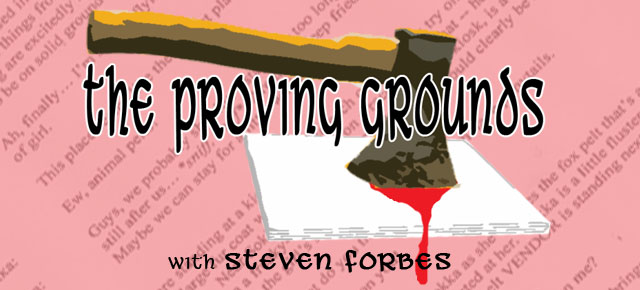



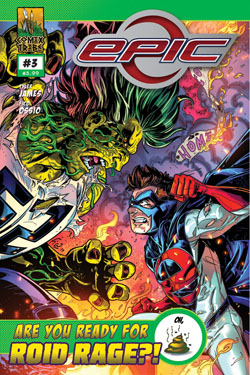

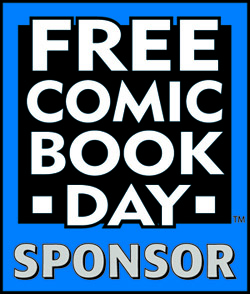


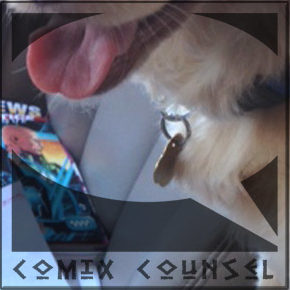
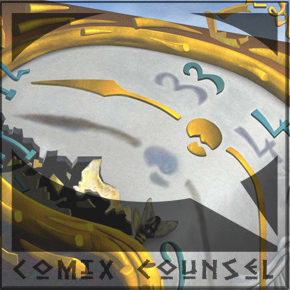

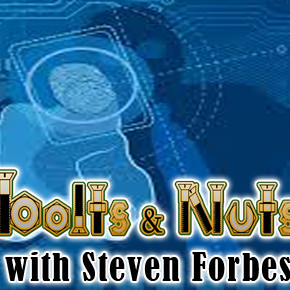
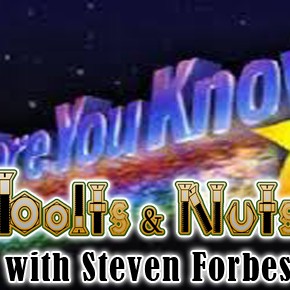



As a story, this is a pretty interesting setup. Totally surreal, so obviously not everyone’s cup of tea, but Jamie’s clearly got the ideas. He also has something of a sense of structure, as seen by his solid grasp of formatting. The downfall, as Steve points out, lies in the grammar and punctuation. And unfortunately, these are the basic building blocks on top of which the rest of the script is built.
(By the way, on page 5, panel 5, do the two problems revolve around “you’re self”? First, it should be “your” rather than “you are”, and second, it should be one word: “yourself”.)
As well as the punctuation issues, there are – as Steve pointed out – some elements of meandering panels that don’t immediately get to the point. While that may be part of the style, in the early pages at least it’s important to hook the reader. If Aaron Funk’s intro, and the concept of a physical narrator in a room somewhere talking about him, were all condensed into the first page, Aaron’s “arrival” on page 2 would make a killer page-turn title page that would make one hell of a hook.
But despite the problems, I like the nuttiness of the Aaron Funk concept, and some of the ideas at play here. It’s just the execution that could be refined in redrafts. With a good enough editor to tighten everything up, I think this could be a fun, perfectly readable yarn.
Wow, I thought you might have problems with that script, but I didn’t particularly think that punctuation would be one of them. Not because I’m particularly great with grammar, but because I’m (very) dyslexic, and therefore get someone to proof read pretty much everything I write. I’m not trying to pass the blame to anyone else, I’m just saying that it came as a surprise.
As far as the pacing goes, I think your 100% correct. I think I will at some point go back and cut out a few pages here and there, not just in the 5 here, but later on as well. This awful pacing does have a reason though.
Usually when I write I’m pretty meticulous about planning. I start out by describing the story in a single line, then expand it to a paragraph or so for each chapter before writing out a detailed plan, all before I write a word of script.
I did not do that here. If the method I just described is how I try and write “pop” comic. this is my attempt at avant-garde jazz. (In other words, I made it up as I went along).
Overall, I think I agree with pretty much everything you said here, but I do have one small point:
“Canada is easy to spot. Not so for India. Not for North Americans. Not when you haven’t called for any labels on the maps.”
Whoever said this was aimed at North Americans? Here in Britain if someone can’t recognise a map of India, they probably can’t read either*, so I’m not too worried about loosing them as a demographic 😉
Having said that, there is not reason not to put labels on the map, and that may be one of the panels I chuck on the big page bonfire.
I think I might submit one of my more structured scripts later on, but only after I’ve proof read it again myself.
Jamie
*that’s not just a cheap dig at America, half of our culture was stolen from India, so it’s pretty recognisable here.
HA!
There are times, Jamie, when I forget we’re from different sides of the puddle.
I did NOT know, however, that you’re dyslexic.
To be honest, when I read your redoing of that Mars story, I was quite shocked, because I thought it was far superior to this submission. And I was TOTALLY and EXTREMELY surprised at the lack of punctuation. I never recalled that as being a problem of yours. I feel much better now.
When it comes to the pacing thing… I understand about making it up as you go along. I’m a fan of it, really. But I’m a fan of it in the plotting stage. This way, you can see if you have enough story to fill your page count. If not, then you either have to rethink the story, or rethink the page count. Going right from idea to script isn’t my idea of a good time. Some people have that ability, and I’m not one of them, so I’m greatly envious of those that do.
IF you MUST go from idea to script as an experiment, I suggest at least knowing the end of the story/issue before you start. I think it may help.
As for the North American thing… I’m not big on geography. Never have been. But if your story is ONLY going to make the rounds in Europe/Britain, then you don’t have anything to worry about. However, I believe that that shouldn’t dissuade you from labeling the continents/countries if you decide to keep the map panels.
Anyway, get to submittin’! I’ve only got scripts until the middle of March or something… It’s a script crisis!
…on Infinite Earths!
Sorry, couldn’t resist.
The funny thing is that I was just reading an article/review of JLA/Avengers that referenced Crisis on Infinite Earths a few times.
So, we’re in the same head space. (Maybe I can try to get my wife to read Crisis… See if her head’ll ‘splode.)
“But if your story is ONLY going to make the rounds in Europe/Britain, then you don’t have anything to worry about.”
To be perfectly honest, I don’t think I’ll try and get this published. There are stories that I would like to tell and try and get published, but quite frankly I’m not good enough to do that yet. Pretty much everything I’m writing now I’m doing to learn how to write. Hence doing stupid things like writing without planning, just to see how it goes.
I think I’ll go through another of my scripts from the opposite end of the spectrum to make sure it has not glaringly obvious errors and hopefully submit it soon.
Sounds good, Jamie. I’ll be looking forward to it.
First time leaving a comment but I’ve been reading since the start of the week.
Steven, I must say it’s always an exquisite pleasure to take in your observations as well as those of the other usual commenters. Kudos also to the courageous few who braved the Proving Grounds up to now!
This has been of tremendous help to me and I now feel ready to climb over my own personal stumbling block: turning those neat ideas into well-structured scripts.
Who knows? I might very well face the Proving Grounds with a script of my own soon!
Thanks for taking the time to comment, Yannick. I appreciate it.
Really, I’m just here to help. If you’re finding the information here useful, then I’ve done my job, and I can go about my day with a smile on my face. (No, that’s not crap, either. This really is something I enjoy doing.)
As for the Brave Ones… I look at it like this:
You can put up your script at different places around the web, and have comments on them that don’t make much of an impression, because the people commenting don’t know much about what they’re talking about, OR they have difficulty in expressing themselves. Either way, it leads to criticism that isn’t all that helpful. That is, of course, if the script gets any comments at all.
Or, you can submit your script here, for it to be scrutinized and posted, for not just you to learn from, but so that others can learn, as well.
This is the main reason that ComixTribe exists. So that we, as creators, can help other creators make better comics.
And it’s never just “my way” here. I am not the end all, be all when it comes to editing. My goal here in The Proving Grounds isn’t to belittle or be hurtful (although there are times when I can be a little snarky). My goal is to do what other people aren’t: give quality critiques on scripts so that at least SOMEONE has looked at it.
And, really, am I that scary?
Nah, you’re really not that bad, Steven. I work in communications and I’ve had a lot worse from UNqualifeied people looking at my writing and graphic design. Honest competent critique from a true professional is always to be desired.
So snark away!
After all, if I want to get told how good I am, I’ll take my script to my mom and she can put it up on the fridge. Instead – and I think that’s what all “Brave Ones” want – I welcome any opportunity to be told how to get better. The way I see it, it’s about knowing where you really stand right now in order to know the route to where you want to be.
And since I have no more excuses for not writing – thanks to your columns – I’m off to beat an idea into some form of story!
Great! Get to it, and then send it, so I can drop an atomic elbow…um, I mean, piledrive…um, pull out a hatchet…no, that’s not right, either…
Bulldoze?
Napalm?
Figure four?
Arm bar?
Oh! That’s right. Paint nice little daisies on it, and call it “gud.” 😉
To be fair to James – and to get off on the “right” foot of arguing with Steven about moving panels again 🙂 – he did say, “HAS closed the shears, cutting the head off,” indicating (I would think) that it already happened prior to this image, rather than asking for it to actually be shown in this image. This image, the way I read it, depicts the aftermath of the cutting.
I’ve seen this a few times, Steven, where you take what I would simply see as an explanation to the artist of, “how we get from what was happening in the last panel to what is happening in this panel,” (unseen, between panel action – that clarifies the current actions) as a failed description of the current frozen moment. But I will grant that it’s something that might increase the potential for confusion. I wonder if there’s a better way of providing that sort of between-panel information?
As for the issue of India not being clear on the map … I don’t think it would be too critical even for the North American market. That point on the map may not register as “India”, but it certainly should register as “not Canada”. So, unless it’s important that the reader understand that it’s India, specifically, I don’t think I’d worry about it.
On the lighting… it is possible to do a dark scene, lit by the moon, with a person shown mostly in silhouette.* Darkness doesn’t have to mean pitch black, but the lighting direction could have been better.
*I wouldn’t go full-silhouette, as that’s just a blank shadow among other shadows – I’d go with a dark figure with his outline shown by highlights.
Actually, I haven’t seen many writers who describe (or understand) lighting all that well. There are even a lot of artists who don’t understand lighting all that well (I’m hardly an expert, myself), and there are entire books dedicated exclusively to the subject of artistic lighting. The best advice I can think of to help someone quickly get a grasp on dramatic lighting (especially for dark scenes), is to go watch some old black & white film noir movies. Those folks really knew how to use light and darkness for effect – sometimes it’s almost as much a part of the story as the characters. And film noir is just cool.;)
Calvin, I’ve missed ya!
That’s really all I have to say. 🙂
Stick around. It’ll be good for everyone.
Heh. Sounds suspiciously like, “If you can’t think of something good to say…” 😉
But someone’s gotta keep you on your toes, right?
Anyway… any thoughts on how it might be possible to provide “pre-action commentary” that might be less inclined to make it read like a moving panel? Or do you think the need for such commentary is, in itself, the result of a flaw in the writing? Anyone?
Nah. You know me better than that.
The reason why I missed ya is because you help to bring good discussion. Everyone learns.
And “pre-action commentary” isn’t needed if you’re thinking in still panels. Knowing what can be drawn and the limits of the form will cut out any need for a preemptive strike.
“And pre-action commentary isn’t needed if you’re thinking in still panels. Knowing what can be drawn and the limits of the form will cut out any need for a preemptive strike.”
Hmmm… That at least helps explain why you call those instances out as moving panels. But you might be onto something there. I’m going to have to think on that one a bit.
I think this needs some exploration in B&N! Guess I better get to writing…
Hi Calvin!
As far as lighting goes, I come from a background in 3D, and so I’m used to doing things that would not really be possible to have because the light source would be floating in mid air.
If you want a silhouette in darkness in 3d you could use a directional back-light and some fog, and it would give that effect. Having said that, I’m not sure how a comic book artist would be able to do this, and I have 3D comics as a general rule (or I would be doing all my own art)
It would be the same general idea in 2D. To do an edge-lit silhouette, you’ll need to locate your light source behind the figure you’re silhouetting.
You could do that with a “fake” light source (not usually my first choice, but sometimes ideal for that certain touch of drama), or with a “real” light source that exists in the image. Like that large moon – just place the moon low in the sky and you’re all set (if you did a low shot and placed the moon directly behind the figure, you could even have a full silhouette).
And don’t forget reflected light sources. You called for a swamp, which means areas of water that could be reflecting a bit of moonlight wherever you need it. Honestly, while you didn’t spell it all out in specific detail, you (by accident or design) did provide enough elements to allow an artist to make a scene like that work. And that sure beats the scripts that call for a ton of details to be visible, in the pitch dark, with no light source at all.
*hate, not have
AH! Now that makes a LOT more sense!
I will admit to being clueless about lighting. When I mention it at all in a script, I tend to just convey a general effect I’d like, then end the note in a question mark, asking the artist if it’s possible given the light source to do it.